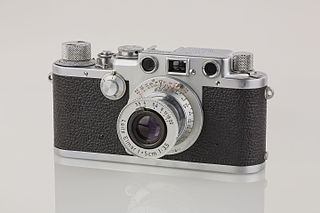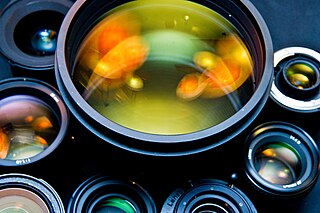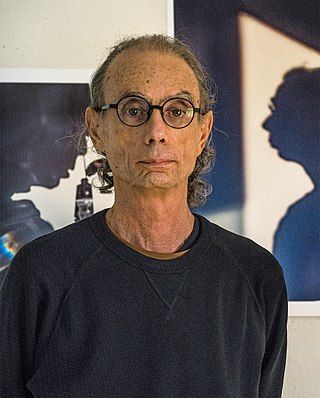
Photography is the art, application, and practice of creating images by recording light, either electronically by means of an image sensor, or chemically by means of a light-sensitive material such as photographic film. It is employed in many fields of science, manufacturing, and business, as well as its more direct uses for art, film and video production, recreational purposes, hobby, and mass communication. A person who makes photographs is called a photographer.

A camera is an instrument used to capture and store images and videos, either digitally via an electronic image sensor, or chemically via a light-sensitive material such as photographic film. As a pivotal technology in the fields of photography and videography, cameras have played a significant role in the progression of visual arts, media, entertainment, surveillance, and scientific research. The invention of the camera dates back to the 19th century and has since evolved with advancements in technology, leading to a vast array of types and models in the 21st century.

A pinhole camera is a simple camera without a lens but with a tiny aperture —effectively a light-proof box with a small hole in one side. Light from a scene passes through the aperture and projects an inverted image on the opposite side of the box, which is known as the camera obscura effect. The size of the images depends on the distance between the object and the pinhole.

A camera lens is an optical lens or assembly of lenses used in conjunction with a camera body and mechanism to make images of objects either on photographic film or on other media capable of storing an image chemically or electronically.
Panoramic photography is a technique of photography, using specialized equipment or software, that captures images with horizontally elongated fields of view. It is sometimes known as wide format photography. The term has also been applied to a photograph that is cropped to a relatively wide aspect ratio, like the familiar letterbox format in wide-screen video.
Bill Brandt was a British photographer and photojournalist. Born in Germany, Brandt moved to England, where he became known for his images of British society for such magazines as Lilliput and Picture Post; later he made distorted nudes, portraits of famous artists and landscapes. He is widely considered to be one of the most important British photographers of the 20th century.
The science of photography is the use of chemistry and physics in all aspects of photography. This applies to the camera, its lenses, physical operation of the camera, electronic camera internals, and the process of developing film in order to take and develop pictures properly.

Fine-art photography is photography created in line with the vision of the photographer as artist, using photography as a medium for creative expression. The goal of fine-art photography is to express an idea, a message, or an emotion. This stands in contrast to representational photography, such as photojournalism, which provides a documentary visual account of specific subjects and events, literally representing objective reality rather than the subjective intent of the photographer; and commercial photography, the primary focus of which is to advertise products or services.
The following outline is provided as an overview of and topical guide to photography:
Lo-fi photography refers to unconventional photographic practices, chosen for aesthetics, which give an impression of low quality. Popular techniques include the use of toy cameras or pinhole cameras, for their distinctive stylistic effects. It can be considered a reaction to the perceived ease of creating technically perfect photos in the digital age. Some emphasize a return to film, while others use digital technology to accomplish the same effects. Low-fidelity photography has also been commonly linked with lo-fi music as well.
Jerry Spagnoli, a photographer since the mid-1970s, is best known for his work with the daguerreotype process, a complex photographic technique invented in 1839 that produces images on highly polished, silver clad copper plates. Initiating his exploration of the daguerreotype in San Francisco in 1994, Spagnoli experimented with nineteenth-century materials and studied the effects achieved by early practitioners to understand the technical aspects of the process, as well as its expressive and visual potential as a medium. He began work on an ongoing series entitled “The Last Great Daguerreian Survey of the 20th Century” in 1995, continuing the series upon returning to the east coast in 1998. The project features views of the metropolis as well as images of historically significant events including the destruction of the World Trade Center on 9/11, the vigil following the disappearance of John F. Kennedy, Jr., and Times Square at midnight on the eve of the new millennium. Considered the leading expert in the revitalization of the daguerreotype process, Spagnoli is also noted for his collaboration with artist Chuck Close on daguerreotype portraits and nudes.

Full-spectrum photography is a subset of multispectral imaging, defined among photography enthusiasts as imaging with consumer cameras the full, broad spectrum of a film or camera sensor bandwidth. In practice, specialized broadband/full-spectrum film captures visible and near infrared light, commonly referred to as the "VNIR".

As of 2011, The Great Picture holds the Guinness World Record for the largest print photograph, and the camera with which it was made holds a record for being the world's largest. The photograph was taken in 2006 as part of the Legacy Project, a photographic compilation and record of the history of Marine Corps Air Station El Toro as it is being transformed into the Orange County Great Park. The project used the abandoned F-18 hangar #115 at the closed fighter base in Irvine, California, United States, as the world's largest pinhole camera. The aim was to make a black-and-white negative print of the Marine Corps air station with its control tower and runways, with the San Joaquin Hills in the background. The photograph was unveiled on July 12, 2006, during a reception held in the hangar and was exhibited for the first time at the Art Center College of Design in Pasadena, California, on September 6, 2007.
Willie Anne Wright is an American photographer best known for her colorful cibachrome and grayscale Pinhole Photography.

Fine art nude photography is a genre of fine-art photography which depicts the nude human body with an emphasis on form, composition, emotional content, and other aesthetic qualities. The nude has been a prominent subject of photography since its invention, and played an important role in establishing photography as a fine art medium. The distinction between fine art photography and other subgenres is not absolute, but there are certain defining characteristics.
Bill Armstrong is a New York based fine art photographer who is known for his blurred color photographs. He grew up in Concord, Massachusetts.
Robert J. Hirsch is an American artist, curator, educator, historian, and author. He is best known for his writing about color and digital imaging and about the history of photography, and as an advocate for photographers who offer a haptic, expressionist interpretation of their subject matter.
Holly Roberts is an American visual artist known best for her combination of photography and paint. “Holly Roberts caused a stir in the fine art photography world of the eighties by fusing painting and photography, painting directly onto photographs”. Roberts lives and works in Corrales, New Mexico. Her work is in the permanent collection of several museums in the United States.

David Lebe is an American photographer. He is best known for his experimental images using techniques such as pinhole cameras, hand-painted photographs, photograms, and light drawings. Many of his photographs explore issues of gay identity, homoeroticism, and living with AIDS, linking his work to that of contemporaries such as Robert Mapplethorpe, Peter Hujar, and David Wojnarowicz. Though his style and approach set him apart from these contemporaries, "Lebe is now incontrovertibly part of the history of twentieth-century queer artists."
Anne Savedge is an American photographic artist and art educator.








